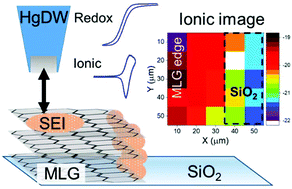Our official English website, www.x-mol.net, welcomes your feedback! (Note: you will need to create a separate account there.)
Coordinated mapping of Li+ flux and electron transfer reactivity during solid-electrolyte interphase formation at a graphene electrode.
Analyst ( IF 4.2 ) Pub Date : 2020/02/19 , DOI: 10.1039/c9an02637a Zachary T Gossage 1 , Jingshu Hui , Dipobrato Sarbapalli , Joaquín Rodríguez-López
Analyst ( IF 4.2 ) Pub Date : 2020/02/19 , DOI: 10.1039/c9an02637a Zachary T Gossage 1 , Jingshu Hui , Dipobrato Sarbapalli , Joaquín Rodríguez-López
Affiliation

|
Interphases formed at battery electrodes are key to enabling energy dense charge storage by acting as protection layers and gatekeeping ion flux into and out of the electrodes. However, our current understanding of these structures and how to control their properties is still limited due to their heterogenous structure, dynamic nature, and lack of analytical techniques to probe their electronic and ionic properties in situ. In this study, we used a multi-functional scanning electrochemical microscopy (SECM) technique based on an amperometric ion-selective mercury disc-well (HgDW) probe for spatially-resolving changes in interfacial Li+ during solid electrolyte interphase (SEI) formation and for tracking its relationship to the electronic passivation of the interphase. We focused on multi-layer graphene (MLG) as a model graphitic system and developed a method for ion-flux mapping based on pulsing the substrate at multiple potentials with distinct behavior (e.g. insertion-deinsertion). By using a pulsed protocol, we captured the localized uptake of Li+ at the forming SEI and during intercalation, creating activity maps along the edge of the MLG electrode. On the other hand, a redox probe showed passivation by the interphase at the same locations, thus enabling correlations between ion and electron transfer. Our analytical method provided direct insight into the interphase formation process and could be used for evaluating dynamic interfacial phenomena and improving future energy storage technologies.
中文翻译:

在石墨烯电极上形成固态电解质界面的过程中,Li +通量与电子转移反应性的协调映射。
在电池电极处形成的相间通过充当保护层并保持进入和流出电极的离子通量而成为实现能量密集电荷存储的关键。但是,由于它们的异质结构,动态性质以及缺乏用于现场探测其电子和离子性质的分析技术,我们目前对这些结构以及如何控制其性质的理解仍然受到限制。在这项研究中,我们使用了基于安培离子选择性汞盘阱(HgDW)探针的多功能扫描电化学显微镜(SECM)技术,用于空间分辨固体电解质界面(SEI)形成过程中界面Li +的变化,并用于跟踪其与相电子钝化的关系。我们将多层石墨烯(MLG)作为模型石墨系统进行了研究,并开发了一种基于离子束通量映射的方法,该方法基于在具有不同行为(例如插入-插入)的多个电位下对基板施加脉冲。通过使用脉冲协议,我们捕获了形成的SEI和嵌入过程中Li +的局部摄取,沿着MLG电极的边缘创建了活性图。另一方面,氧化还原探针在相同位置处被相间钝化,因此可以实现离子和电子转移之间的相关性。我们的分析方法提供了对相形成过程的直接了解,可用于评估动态界面现象和改进未来的储能技术。插入-插入)。通过使用脉冲协议,我们捕获了形成的SEI和嵌入过程中Li +的局部摄取,沿着MLG电极的边缘创建了活性图。另一方面,氧化还原探针在相同位置显示出被相间钝化,从而使离子和电子转移之间具有相关性。我们的分析方法提供了对相形成过程的直接了解,可用于评估动态界面现象和改进未来的储能技术。插入-插入)。通过使用脉冲协议,我们捕获了形成的SEI和嵌入过程中Li +的局部摄取,沿着MLG电极的边缘创建了活性图。另一方面,氧化还原探针在相同位置处被相间钝化,因此可以实现离子和电子转移之间的相关性。我们的分析方法提供了对相形成过程的直接了解,可用于评估动态界面现象和改进未来的储能技术。因此可以实现离子和电子转移之间的关联。我们的分析方法提供了对相形成过程的直接了解,可用于评估动态界面现象和改进未来的储能技术。因此可以实现离子和电子转移之间的关联。我们的分析方法提供了对相形成过程的直接了解,可用于评估动态界面现象和改进未来的储能技术。
更新日期:2020-03-31
中文翻译:

在石墨烯电极上形成固态电解质界面的过程中,Li +通量与电子转移反应性的协调映射。
在电池电极处形成的相间通过充当保护层并保持进入和流出电极的离子通量而成为实现能量密集电荷存储的关键。但是,由于它们的异质结构,动态性质以及缺乏用于现场探测其电子和离子性质的分析技术,我们目前对这些结构以及如何控制其性质的理解仍然受到限制。在这项研究中,我们使用了基于安培离子选择性汞盘阱(HgDW)探针的多功能扫描电化学显微镜(SECM)技术,用于空间分辨固体电解质界面(SEI)形成过程中界面Li +的变化,并用于跟踪其与相电子钝化的关系。我们将多层石墨烯(MLG)作为模型石墨系统进行了研究,并开发了一种基于离子束通量映射的方法,该方法基于在具有不同行为(例如插入-插入)的多个电位下对基板施加脉冲。通过使用脉冲协议,我们捕获了形成的SEI和嵌入过程中Li +的局部摄取,沿着MLG电极的边缘创建了活性图。另一方面,氧化还原探针在相同位置处被相间钝化,因此可以实现离子和电子转移之间的相关性。我们的分析方法提供了对相形成过程的直接了解,可用于评估动态界面现象和改进未来的储能技术。插入-插入)。通过使用脉冲协议,我们捕获了形成的SEI和嵌入过程中Li +的局部摄取,沿着MLG电极的边缘创建了活性图。另一方面,氧化还原探针在相同位置显示出被相间钝化,从而使离子和电子转移之间具有相关性。我们的分析方法提供了对相形成过程的直接了解,可用于评估动态界面现象和改进未来的储能技术。插入-插入)。通过使用脉冲协议,我们捕获了形成的SEI和嵌入过程中Li +的局部摄取,沿着MLG电极的边缘创建了活性图。另一方面,氧化还原探针在相同位置处被相间钝化,因此可以实现离子和电子转移之间的相关性。我们的分析方法提供了对相形成过程的直接了解,可用于评估动态界面现象和改进未来的储能技术。因此可以实现离子和电子转移之间的关联。我们的分析方法提供了对相形成过程的直接了解,可用于评估动态界面现象和改进未来的储能技术。因此可以实现离子和电子转移之间的关联。我们的分析方法提供了对相形成过程的直接了解,可用于评估动态界面现象和改进未来的储能技术。


























 京公网安备 11010802027423号
京公网安备 11010802027423号